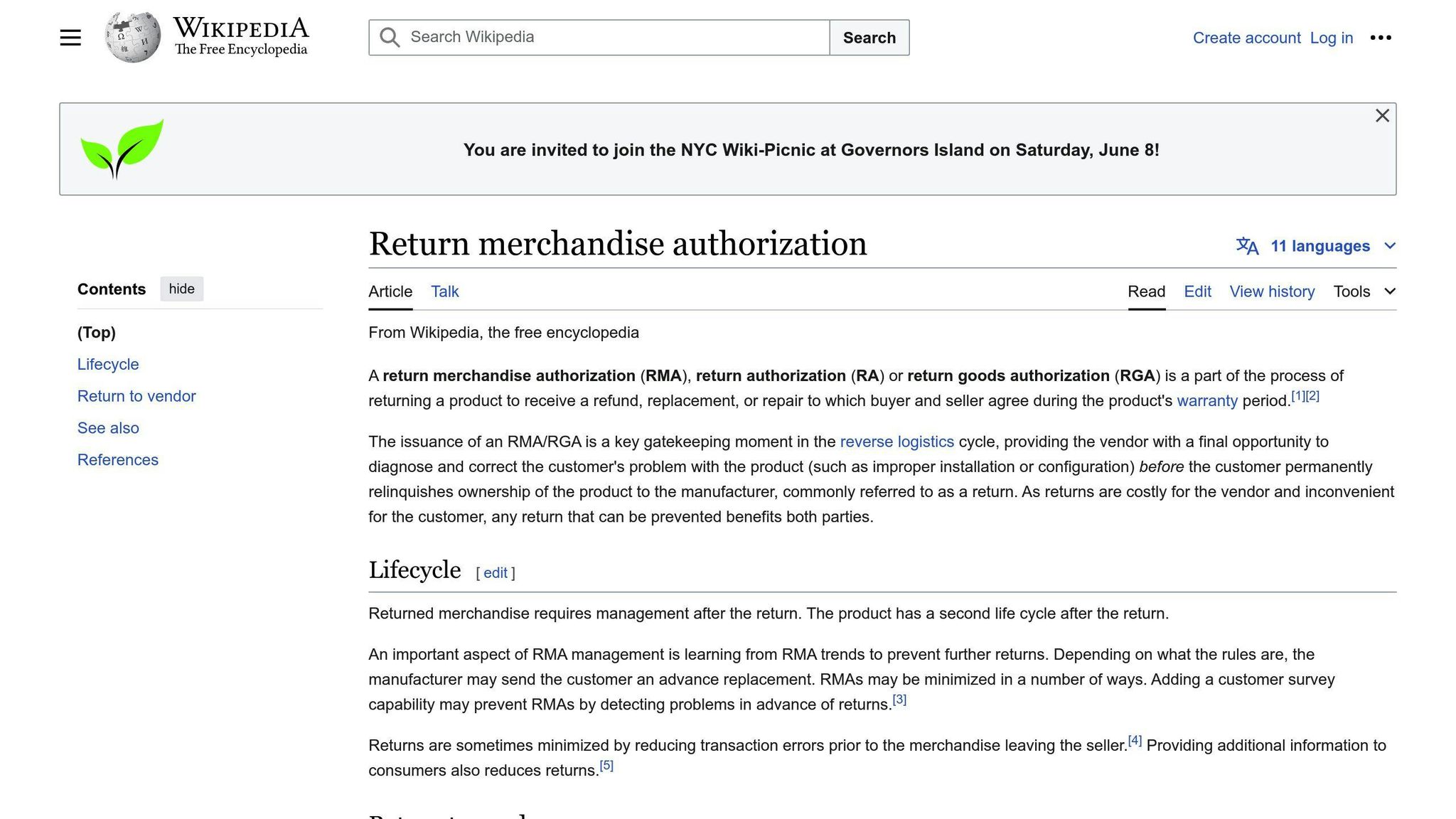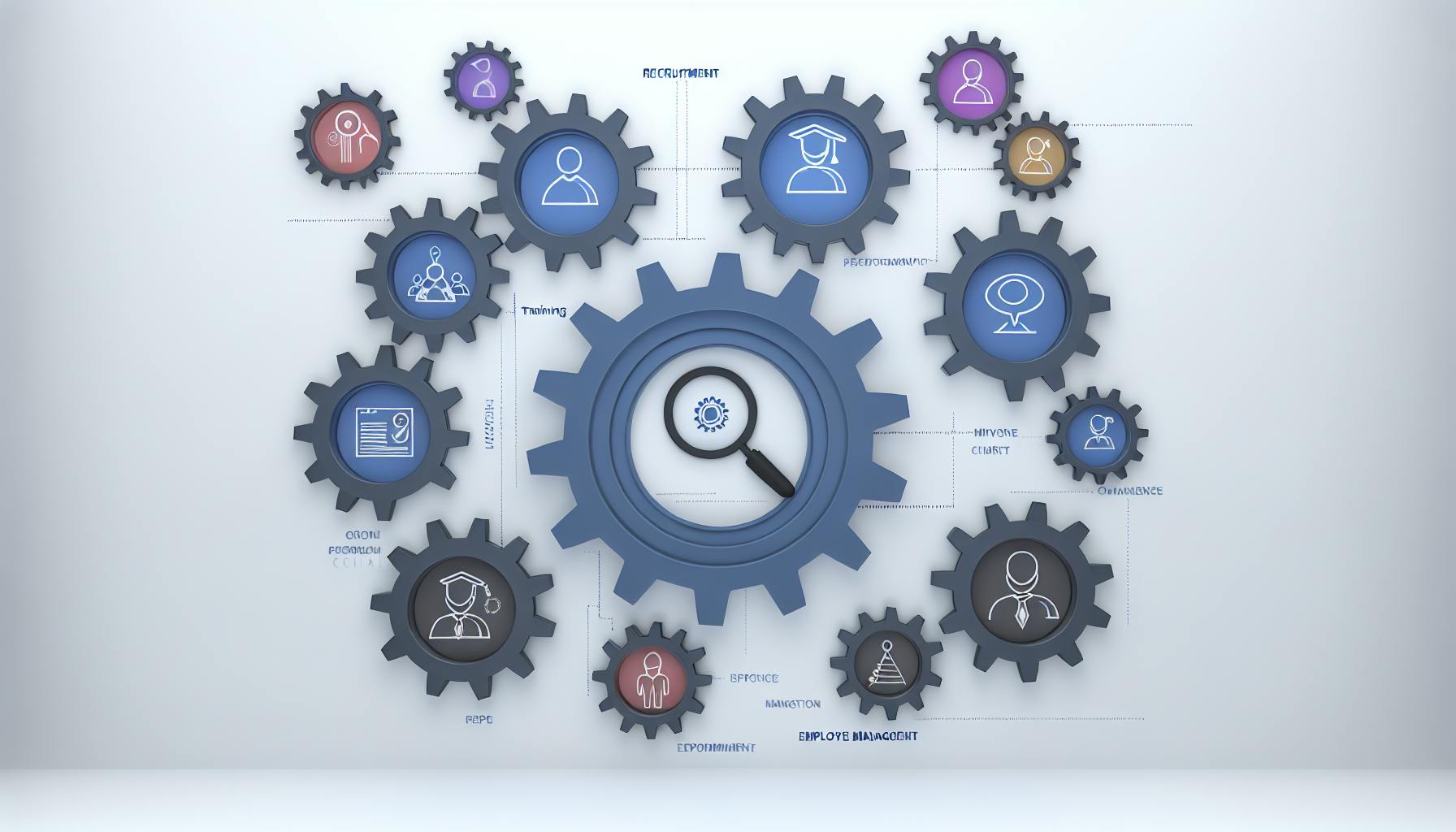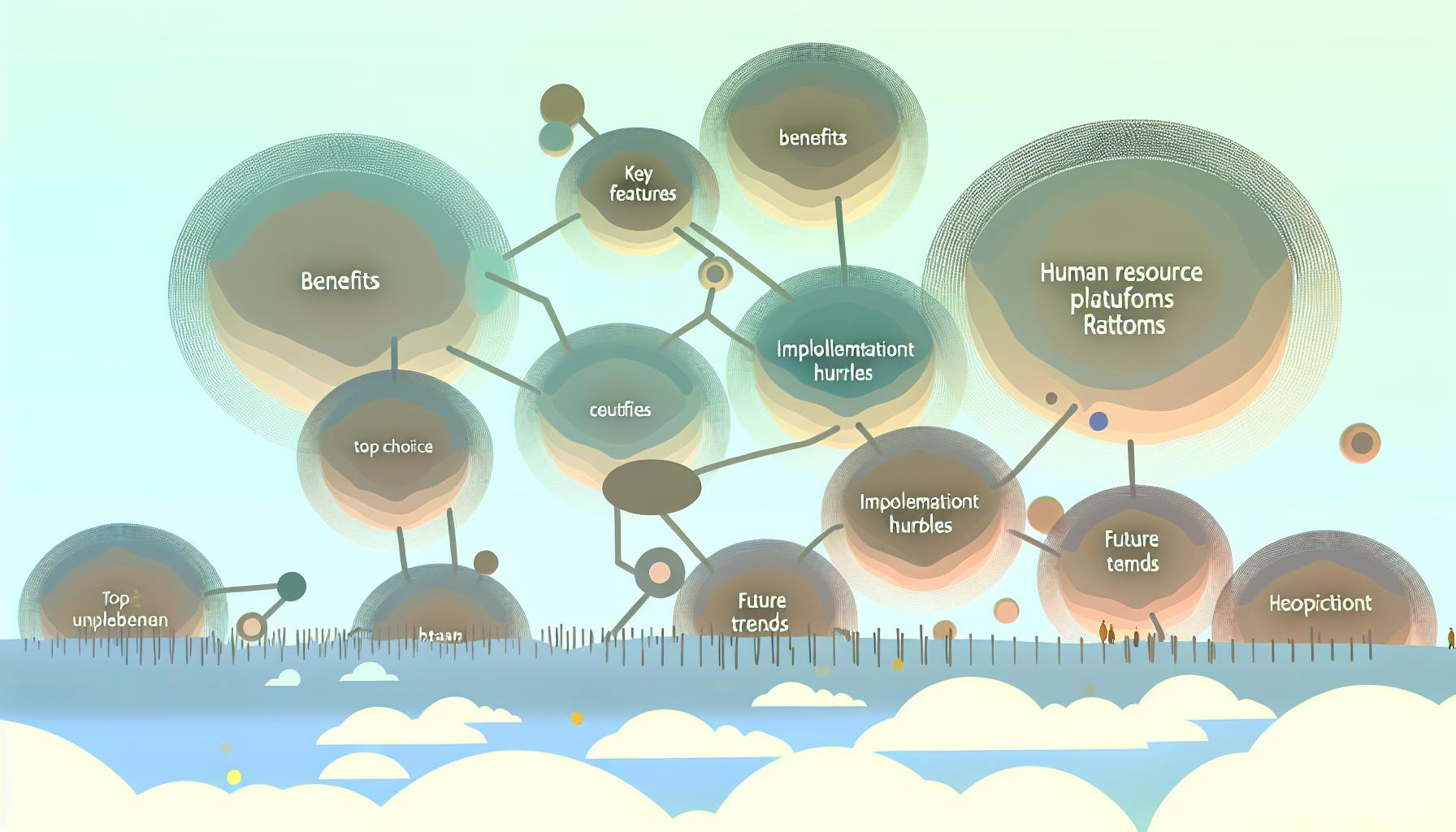An RMA (Return Merchandise Authorization) system streamlines product returns across sales channels, boosting customer satisfaction and operational efficiency. This guide covers:
Key Benefits of RMA Systems
- Improve customer experience with efficient returns
- Automate return management to reduce manual effort
- Minimize losses from unsalable merchandise
- Gain insights from return data to optimize processes
Setting Up an RMA System
- Assess your business needs (return volume, policies, inventory management)
- Choose a scalable system that integrates with existing systems
- Implement a unified process for all sales channels
- Configure channel-specific return policies
The RMA Process
- Customer initiates return request
- Generate and track unique RMA number
- Receive, inspect, and handle returned items
- Communicate with customer throughout
Best Practices
- Clear return policies
- Positive customer experience
- Thorough staff training
- Maintain data accuracy
Evaluating Performance
- Track key metrics (return rate, processing time, customer satisfaction)
- Measure cost savings and efficiency gains
- Analyze customer feedback
Future Trends
- AI/ML for predicting returns and tailoring processes
- Sustainable reverse logistics practices
- Adapting to evolving customer needs and expectations
By implementing an effective RMA system, businesses can streamline multi-channel returns, reduce costs, and foster customer loyalty.
Quick Comparison: RMA System Benefits
| Benefit | Description |
|---|---|
| Customer Satisfaction | Efficient return processes enhance customer experience and loyalty |
| Operational Efficiency | Automated and centralized return management reduces manual effort |
| Cost Savings | Minimizes losses from unsalable merchandise and overhead costs |
| Data-Driven Insights | Return data provides insights to optimize policies and strategies |
Related video from YouTube
Understanding RMA Systems

What is an RMA system?
An RMA (Return Merchandise Authorization) system is a process for managing product returns from your online store. It typically involves:
- A form for customers to submit their return request and reason
- Generating a return shipping label or documentation
- Tracking returns and updating inventory levels
- Processing refunds or exchanges
Key Components
An effective RMA system should include:
1. Customer Return Portal
A dedicated platform where customers can initiate and track their returns.
2. RMA Numbers
Unique identifiers assigned to each return, enabling easy tracking and processing.
3. Inventory Integration
Connection with your inventory management system to update stock levels accurately.
4. Customer Communication Tools
Automated notifications and updates to keep customers informed throughout the process.
Benefits of Using an RMA System
| Benefit | Description |
|---|---|
| Improved Customer Experience | Efficient return processes lead to increased customer satisfaction and loyalty. |
| Streamlined Operations | Automated and centralized return management reduces manual effort and errors. |
| Cost Savings | Minimizes losses from unsalable merchandise and reduces overhead costs. |
| Valuable Data | Provides insights to optimize your return policy and overall business strategy. |
Setting Up an RMA System
Before setting up an RMA system, it's crucial to understand your business's return management needs. Consider factors like:
- Return volume: How many returns do you process monthly?
- Common return reasons: Why do customers return products (e.g., defects, incorrect orders, dissatisfaction)?
- Return policies: What are your current policies, and do they vary by product or region?
- Inventory management: How do you currently manage inventory, and how will returns impact stock levels?
- Customer expectations: What kind of return experience do your customers expect?
Assessing these factors will help you choose an RMA system that meets your unique needs.
Selecting the Right RMA System
When choosing an RMA system, evaluate the following:
| Factor | Description |
|---|---|
| Scalability | Can the system handle increased return volumes and complexity as your business grows? |
| Integration | Can it integrate with your existing inventory, order management, and other systems? |
| Cost | What are the upfront and ongoing costs, and how will it impact your bottom line? |
| Customization | Can the system be tailored to your specific business needs and return policies? |
| Support | What kind of support does the provider offer to help resolve issues? |
Carefully considering these factors will help you choose an RMA system that meets your business needs and provides a positive return experience for customers.
Integrating with Existing Systems
To ensure a seamless return process, integrate your RMA system with:
1. Inventory Management
Update stock levels in real-time to reflect returned items.
2. Order Management
Automatically update order statuses and trigger refunds or exchanges.
3. Customer Relationship Management (CRM)
Sync customer interactions and return history for improved customer service.
Automate refund and exchange processing to minimize manual errors and reduce financial losses.
Integrating your RMA system with existing systems will streamline your return process, reduce errors, and improve overall efficiency.
The RMA Process
The RMA process is key to managing returns smoothly. It involves a series of steps that ensure a hassle-free return experience for customers. In this section, we'll go over the details of the RMA process, including starting a return, creating and tracking RMA numbers, receiving and inspecting returns, handling returned items, and communicating with customers.
Starting a Return Request
The return process begins when a customer requests a return. This can be done through various channels like online portals, phone, or email. It's important to provide a clear return policy that outlines the steps for customers to initiate a return.
To make it easier, businesses can offer a returns portal on their website. Here, customers can log in, request a return, select the reason, provide details, and upload any relevant documents.
Creating and Tracking RMA Numbers
Once a return request is made, a unique RMA number is generated. This number is used to track the return and ensure efficient processing. RMA numbers can be generated automatically through an RMA system or manually by customer service.
Tracking RMA numbers is crucial to process returns correctly and prevent fraud. Businesses can use RMA software to track returns, update inventory levels, and notify customers of the return status.
Receiving and Inspecting Returns
When a returned item arrives, it's inspected to determine its condition and if it meets the return criteria. This step is critical to process returns correctly and ensure customers receive appropriate resolutions.
| Step | Description |
|---|---|
| 1. Verify RMA Number | Match the returned item with the RMA number to ensure proper tracking. |
| 2. Inspect Condition | Check the item's condition against the return reason and policy. |
| 3. Document Findings | Note any damages, missing parts, or other issues for further action. |
Handling Returned Items
After inspection, businesses must decide how to handle the returned items. Options may include:
- Refund or Exchange: If the return meets the policy, process a refund or exchange as requested.
- Repair or Repackage: For minor issues, repair or repackage the item for resale.
- Dispose or Recycle: If the item is damaged beyond repair or resale, dispose of it responsibly or recycle components.
Communicating with Customers
Clear communication is vital throughout the RMA process. Businesses should:
- Acknowledge receipt of the return
- Provide updates on the return status
- Notify customers of any issues or delays
- Confirm resolution (refund, exchange, or other outcome)
Timely and transparent communication builds trust and enhances the customer experience.
Managing Multi-Channel Returns
Challenges with Different Sales Channels
Managing returns from various sales channels can be tricky:
- Online vs. Physical Stores: Returns from online channels may require different handling than in-store returns.
- Marketplace Rules: Returns from sites like Amazon or eBay may have specific requirements to follow.
- Inventory Tracking: Keeping track of returns and inventory across multiple channels is complex.
Unified Return Process
To simplify multi-channel returns, implement a unified RMA system that integrates with all sales channels. This provides:
- A single platform for managing all returns
- Consistent handling, regardless of the channel
- Better customer experience
Channel-Specific Policies
Different sales channels may have varying return policies and procedures:
| Channel | Example Policy |
|---|---|
| Marketplaces | Stricter return windows, specific packaging |
| Physical Stores | In-store returns only, receipt required |
| Online Store | Longer return periods, free return shipping |
Configure your RMA system to recognize and apply the relevant policies for each channel. This ensures returns are processed correctly based on the channel's requirements.
sbb-itb-d1a6c90
Improving the RMA Process
Enhancing the RMA process is crucial for reducing returns, boosting customer satisfaction, and improving overall business efficiency. By streamlining and optimizing the returns process, companies can minimize the negative impact of returns on their bottom line.
Automating RMA Tasks
Automating various aspects of the RMA process can save time, reduce errors, and increase efficiency. This can be achieved by implementing automated workflows for tasks such as:
- Generating RMA numbers and return labels
- Sending notifications to customers and internal teams
- Updating inventory levels and tracking returns
- Processing refunds and exchanges
By automating these tasks, businesses can free up staff to focus on resolving customer issues and improving the overall customer experience.
Utilizing Data and Analytics
Collecting and analyzing data from RMA systems can provide valuable insights into return trends, customer behavior, and product performance. This data can be used to:
| Data Utilization | Description |
|---|---|
| Identify Process Improvements | Find areas to enhance the returns process |
| Optimize Products | Improve product design and quality control |
| Develop Marketing Strategies | Create targeted campaigns to reduce returns |
| Enhance Customer Satisfaction | Improve customer satisfaction and loyalty |
By leveraging data and analytics, businesses can make informed decisions to drive growth, reduce costs, and enhance customer satisfaction.
Addressing Common Challenges
Recognizing and addressing common issues in the RMA process can help businesses overcome obstacles and improve overall efficiency. Some common challenges include:
1. Delays in Processing
Delays in processing returns and refunds can frustrate customers and lead to dissatisfaction.
2. Inaccurate Product Information
Incomplete or incorrect product details can result in misunderstandings and unnecessary returns.
3. Tracking Difficulties
Difficulty in tracking returns and inventory can lead to inefficiencies and errors.
4. Insufficient Communication
Lack of communication with customers can create confusion and mistrust.
Best Practices for RMA Systems
Here are proven strategies to make your RMA system efficient and effective.
Clear Return Policies
Having straightforward return policies that customers can easily understand is key. This includes:
- Clearly stating what items can be returned
- Specifying the return window
- Explaining shipping costs and timelines
- Providing detailed instructions for starting a return
By giving transparent guidelines, you can reduce confusion, minimize disputes, and keep customers satisfied.
Positive Customer Experience
Creating a positive return experience builds loyalty and trust. To achieve this:
- Respond promptly to customer inquiries
- Communicate clearly throughout the process
- Offer flexible return options
- Show empathy and understanding
- Follow up to ensure issues are resolved
Turning a negative experience into a positive one encourages customers to keep doing business with you.
Training Staff
Providing thorough training on using the RMA system is essential. This ensures a smooth process by:
- Educating staff on system features and benefits
- Reducing errors and improving efficiency
- Enhancing customer satisfaction
To train staff effectively:
| Training Approach | Description |
|---|---|
| In-depth Training | Cover system features and functionality |
| Ongoing Support | Offer resources and address questions |
| Knowledge Base | Develop an FAQ section for reference |
| Regular Updates | Conduct sessions on system changes |
Maintaining Data Accuracy
Ensuring accurate data from the RMA system is critical for making informed decisions. To maintain accuracy:
- Regularly review and update data
- Implement validation and verification processes
- Use analytics tools to identify trends
- Develop a data governance policy
- Conduct regular audits for accuracy and compliance
Evaluating RMA System Performance
Assessing how well your RMA system works is key to understanding its impact on your business and finding areas to improve. This section covers the main metrics to track, how to measure customer satisfaction, and ways to analyze cost savings and efficiency.
Key Performance Metrics
To evaluate your RMA system's effectiveness, monitor these essential metrics:
- Return rate: The percentage of products returned compared to total sales.
- Processing time: How long it takes to process returns, from receiving the item to issuing a refund or exchange.
- Customer satisfaction: Measured through surveys, Net Promoter Score (NPS), or Customer Effort Score (CES).
- Cost savings: The reduction in costs achieved through efficient returns management.
- Efficiency: The streamlining of processes, reducing manual errors, and increasing automation.
Measuring Customer Satisfaction
Customer satisfaction is crucial when evaluating RMA system performance. To measure it, you can:
| Method | Description |
|---|---|
| Surveys | Gather feedback on the returns process, product quality, and overall experience. |
| Net Promoter Score (NPS) | Gauge customer loyalty and satisfaction. |
| Customer Effort Score (CES) | Measure the effort customers exert to complete a return. |
| Feedback Analysis | Identify areas for improvement from customer comments. |
Analyzing Cost Savings and Efficiency
To assess the financial benefits of your RMA system, calculate:
| Metric | Description |
|---|---|
| Returns Processing Costs | The reduction in costs for handling returns. |
| Inventory Holding Costs | The decrease in costs for storing inventory. |
| Revenue | The increase in revenue through efficient returns management. |
| Supply Chain Efficiency | The improvement in supply chain operations. |
| Waste and Environmental Impact | The reduction in waste and environmental impact. |
Future Trends and Considerations
New Technologies for RMA Systems
Artificial intelligence (AI) and machine learning (ML) will transform returns management. AI algorithms can analyze customer behavior to predict return likelihood, helping businesses tailor RMA processes and reduce unnecessary returns. AI-powered chatbots can also improve customer communication, providing instant support and reducing workloads for customer service teams.
Sustainable Reverse Logistics
As consumers become more eco-conscious, businesses must prioritize sustainability in their returns processes. This includes adopting reverse logistics strategies that:
- Reduce waste
- Minimize carbon emissions
- Promote reuse and recycling of returned items
By incorporating sustainable practices into RMA systems, businesses can reduce their environmental impact and appeal to environmentally-aware customers.
Adapting to Changing Customer Needs
Customer expectations are evolving rapidly. Businesses must adapt their RMA systems to:
- Provide flexible return policies
- Offer multiple return channels
- Ensure seamless communication throughout returns
By staying attuned to customer preferences and market trends, businesses can create a competitive advantage and build customer loyalty.
Comparing New Technologies
| Technology | Benefits |
|---|---|
| AI/ML Algorithms | - Predict return likelihood - Tailor RMA processes - Reduce unnecessary returns |
| AI Chatbots | - Improve customer communication - Provide instant support - Reduce customer service workload |
Sustainable Reverse Logistics Strategies
| Strategy | Description |
|---|---|
| Waste Reduction | Minimize waste from returned items |
| Carbon Emission Reduction | Implement eco-friendly logistics practices |
| Reuse and Recycling | Promote reusing or recycling returned products |
Adapting to Customer Needs
| Need | Solution |
|---|---|
| Flexible Return Policies | Offer various return options and timeframes |
| Multiple Return Channels | Enable returns via online, in-store, or other channels |
| Seamless Communication | Keep customers informed throughout the return process |
Summary
Efficient Return Management is Key
Managing product returns smoothly is crucial for businesses. A well-designed Return Merchandise Authorization (RMA) system can:
- Streamline return processes
- Reduce costs
- Boost customer satisfaction
This guide covered the essentials of RMA systems, from understanding the concept to setting up and improving the process.
Benefits of an RMA System
| Benefit | Description |
|---|---|
| Streamlined Operations | Automated and centralized return management reduces manual effort and errors. |
| Cost Savings | Minimizes losses from unsalable merchandise and reduces overhead costs. |
| Improved Customer Experience | Efficient return processes lead to increased customer satisfaction and loyalty. |
Implementing an RMA System
By implementing a structured RMA system, businesses can:
- Manage returns efficiently across multiple sales channels
- Reduce waste
- Promote sustainability
Staying Ahead
To keep your RMA system effective, it's important to:
- Stay updated on customer needs and market trends
- Adapt to changing expectations
- Leverage new technologies like AI and machine learning
Continuous Improvement
Continuously evaluate and refine your RMA system to ensure it:
- Aligns with your business goals
- Meets customer expectations
Monitor key metrics like:
- Return rate
- Processing time
- Customer satisfaction
- Cost savings
- Efficiency
Analyze data and customer feedback to identify areas for improvement.


